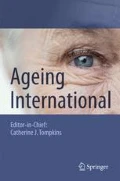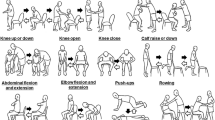Abstract
The purpose of the present study was to investigate effects of type of exercise on the muscle strength and functional performance gains for lower-body in older adults after heavy resistance training. Twenty untrained older adults volunteers (8 men and 12 women) were randomized and placed into two groups: multi-joint exercise—MJ (65 ± 6 years) and single-joint exercise—SJ (62 ± 6 years). Participants were tested twice during control period, and resistance training (RT) effects were assessed after six (middle), and 12 (post) weeks of RT. On test day it was performed a five-repetition maximum (5-RM) tests for leg press (LP), leg extension (LE) and seated leg curl (SLC); stand up 30 s test (SU30), climbing (CS) and down (DS) stairs; time up and go (TUG) and squat jump (SJ). Each group trained 24 sessions. Main effects within and between groups were assessed by Anova. There were increases from pre to middle and post-training (p < 0.05) for 5-RM in all exercises, with no significant differences between groups. Regarding functional performance, CS and DS presented significant improvement after post-training for both groups, (p < 0.05), whereas no differences were observed in the SU30 and TUG test (p > 0.05). No significant changes were observed in the SJ variables after training period (p > 0.05). Multi- and single-joint exercises induced similar gains in the maximal strength and functional performance.




Similar content being viewed by others
References
Ache-Dias, J., Dal Pupo, J., Gheller, R. G., Kulkamp, W., & Moro, A. R. (2016). Power Output Prediction From Jump Height and Body Mass Does Not Appropriately Categorize or Rank Athletes. Journal of Strength and Conditioning Research, 30(3), 818–824. https://doi.org/10.1519/jsc.0000000000001150
Barry, B. K., & Carson, R. G. (2004). The consequences of resistance training for movement control in older adults. The Journals of Gerontology Series A, Biological Sciences and Medical Sciences, 59(7), 730–754. 59/7/M730
Brzycki, M. (1993). Strength Testing-Predicting a One-Rep Max from Reps-to-Fatigue. JOPERD--The Journal of Physical Education, Recreation and Dance, 64(1), 88–90. https://doi.org/10.1080/07303084.1993.10606684
Butler, A. A., Menant, J. C., Tiedemann, A. C., & Lord, S. R. (2009). Age and gender differences in seven tests of functional mobility. Journal of Neuroengineering and Rehabilitation, 6(6), 31. https://doi.org/10.1186/1743-0003-6-31
Byrne, C., Faure, C., Keene, D. J., & Lamb, S. E. (2016). Ageing, Muscle Power and Physical Function: A Systematic Review and Implications for Pragmatic Training Interventions. Sports Medicine. 46(9):1311-32. https://doi.org/10.1007/s40279-016-0489-x
Caserotti, P., Aagaard, P., Buttrup Larsen, J., & Puggaard, L. (2008). Explosive heavy-resistance training in old and very old adults: Changes in rapid muscle force, strength and power. Scandinavian Journal of Medicine and Science in Sports, 18(6), 773–782. https://doi.org/10.1111/j.1600-0838.2007.00732.x
Dal Pupo, J., Detanico, D., & dos Santos, S. G. (2012). Kinetic parameters as determinants of vertical jump performance. Revista Brasileira De Cineantropometria e Desempenho Humano, 14(1), 41–51. https://doi.org/10.5007/1980-0037.2012v14n1p41
Escamilla, R. F., Fleisig, G. S., Zheng, N., Barrentine, S. W., & WILK, Kevin E., & Andrews, JR. (1998). Biomechanics of the Knee during Closed Kinetic Chain and Open Kinetic Chain Exercises. Medicine & Science in Sports & Exercise, 30(4), 556–569. https://doi.org/10.1097/00005768-199804000-00014.
Guizelini, P. C., Aguiar, R. A., Denadai, B. S., Caputo, F., Greco, C. C., de Aguiar, R. A., Denadai, B. S., Caputo, F., & Greco, C. C. (2018). Effect of resistance training on muscle strength and rate of force development in healthy older adults: A systematic review and meta-analysis. Experimental Gerontology, 102, 51–58. https://doi.org/10.1016/j.exger.2017.11.020
Henwood, T. R., Riek, S., & Taaffe, D. R. (2008). Strength Versus Muscle Power-Specific Resistance Training in Community-Dwelling Older Adults. Journal of Gerontology, 63A(1), 83–91. https://doi.org/10.1093/gerona/63.1.83.
Kraska, J. M., Ramsey, M. W., Haff, G. G., Fethke, N., Sands, W. A., Stone, M. E., & Stone, M. H. (2009). Relationship between strength characteristics and unweighted and weighted vertical jump height. International Journal of Sports Physiology and Performance, 4(4), 461–473. http://www.ncbi.nlm.nih.gov/pubmed/20029097
Lombard, W. P. (1903). The Action of Two-Joint Muscles. American Physical Education Review, 8(3), 141–145. https://doi.org/10.1080/23267224.1903.10649915
Lopez, P., Pinto, R. S., Radaelli, R., Rech, A., Grazioli, R., Izquierdo, M., & Cadore, E. L. (2018). Benefits of resistance training in physically frail elderly: A systematic review. Aging Clinical and Experimental Research, 30(8), 889–899. https://doi.org/10.1007/s40520-017-0863-z
Orssatto, L. B. R, Freitas, C. R, Shield, A. J., Pinto, R. S., & Trajano, G. S. (2019). Effects of resistance training concentric velocity on older adults’ functional capacity: A systematic review and meta-analysis of randomised trials. Experimental Gerontology, 127:110731. https://doi.org/10.1016/j.exger.2019.110731
Paoli, A., Gentil, P., Moro, T., Marcolin, G., & Bianco, A. (2017). Resistance training with single vs. multi-joint exercises at equal total load volume: Effects on body composition, cardiorespiratory fitness, and muscle strength. Frontiers in Physiology, 22 (8), 1–6. https://doi.org/10.3389/fphys.2017.01105
Pereira, A., Izquierdo, M., Silva, A. J., Costa, A. M., Bastos, E., González-Badillo, J. J., & Marques, M. C. (2012). Effects of high-speed power training on functional capacity and muscle performance in older women. Experimental Gerontology, 47(3), 250–255. https://doi.org/10.1016/j.exger.2011.12.010
Radaelli, R., Fleck, S. J., Leite, T., Leite, R. D., Pinto, R. S., Fernandes, L., & Simão, R. (2015). Dose-response of 1, 3, and 5 sets of resistance exercise on strength, local muscular endurance, and hypertrophy. Journal of Strength and Conditioning Research / National Strength & Conditioning Association, 29(5), 1349–1358. https://doi.org/10.1519/JSC.0000000000000758
Ramírez-Campillo, R., Castillo, A., de la Fuente, C. I., Campos-Jara, C., Andrade, D. C., Álvarez, C., Martínez, C., Castro-Sepúlveda, M., Pereira, A., Marques, M. C., & Izquierdo, M. (2014). High-speed resistance training is more effective than low-speed resistance training to increase functional capacity and muscle performance in older women. Experimental Gerontology, 58, 51–57. https://doi.org/10.1016/j.exger.2014.07.001
Reid, K. F., Martin, K. I., Doros, G., Clark, D. J., Hau, C., Patten, C., et al. (2014). Comparative Effects of Light or Heavy Resistance Power Training for Improving Lower Extremity Power and Physical Performance in Mobility-Limited Older Adults. The Journals of Gerontology Series A: Biological Sciences and Medical Sciences, 70(3), 374–380. https://doi.org/10.1093/gerona/glu156.
Rhea, M. R. (2004). Determining the magnitude of treatment effects in strength training research through the use of the effect size. Journal of Strength and Conditioning Research / National Strength & Conditioning Association, 18(4), 918–920. https://doi.org/10.1519/14403.1
Rikli, R. E., & Jones, C. J. (2013). Development and validation of criterion-referenced clinically relevant fitness standards for maintaining physical independence in later years. The Gerontologist, 53(2), 255–267. https://doi.org/10.1093/geront/gns071
Sayers, S. P., & Gibson, K. (2012) Effects of high-speed power training on muscle performance and braking speed in older adults. Journal of Aging Research, 2012. https://doi.org/10.1155/2012/426278
Schoenfeld, B., & Contreras, B. (2012). Do Single-Joint Exercises Enhance Functional Fitness? Strength and Conditioning Journal, 34(1), 63–65. https://doi.org/10.1519/SSC.0b013e31823e82d7
Scott, B. R., Duthie, G. M., Thornton, H. R., & Dascombe, B. J. (2016). Training Monitoring for Resistance Exercise: Theory and Applications. In Sports Medicine (Vol. 46, Issue 5, pp. 687–698). Springer International Publishing. https://doi.org/10.1007/s40279-015-0454-0
Simão, R., Spineti, J., de Salles, B. F., Matta, T., Fernandes, L., Fleck, S. J., Rhea, M. R., & Strom-Olsen, H. E. (2012). Comparison Between Nonlinear and Linear Periodized Resistance Training. Journal of Strength and Conditioning Research, 26(5), 1389–1395. https://doi.org/10.1519/JSC.0b013e318231a659
Smith, W. N., Del Rossi, G., Adams, J. B., Abderlarahman, K. Z., Asfour, S. A., Roos, B. A., & Signorile, J. F. (2010). Simple equations to predict concentric lower-body muscle power in older adults using the 30-second chair-rise test: A pilot study. Clinical Interventions in Aging, 5, 173–180. https://doi.org/10.2147/CIA.S7978.
Venturelli, M., Reggiani, C., Richardson, R. S., & Schena, F. (2018). Skeletal Muscle Function in the Oldest-Old: The Role of Intrinsic and Extrinsic Factors. Exercise and Sport Sciences Reviews, 46(3), 188–194. https://doi.org/10.1249/JES.0000000000000155
Acknowledgements
FAPEAM, Foundation for Research Support of the State of Amazonas for PhD scholarship conceded to ES Bezerra (EDITAL N. 001/2014).
Author information
Authors and Affiliations
Corresponding author
Ethics declarations
Conflict of Interest
We declare that they have no conflicts of interest that are relevant to the content of this article.
Additional information
Publisher's Note
Springer Nature remains neutral with regard to jurisdictional claims in published maps and institutional affiliations.
Rights and permissions
About this article
Cite this article
de Souza Bezerra, E., Moro, A.R.P., Sakugawa, R.L. et al. Heavy Resistance Training in Older Adults: Effects of Type Exercise on Functional Capacity, Maximal Muscle Strength and Power. Ageing Int 48, 1–15 (2023). https://doi.org/10.1007/s12126-021-09440-y
Accepted:
Published:
Issue Date:
DOI: https://doi.org/10.1007/s12126-021-09440-y




